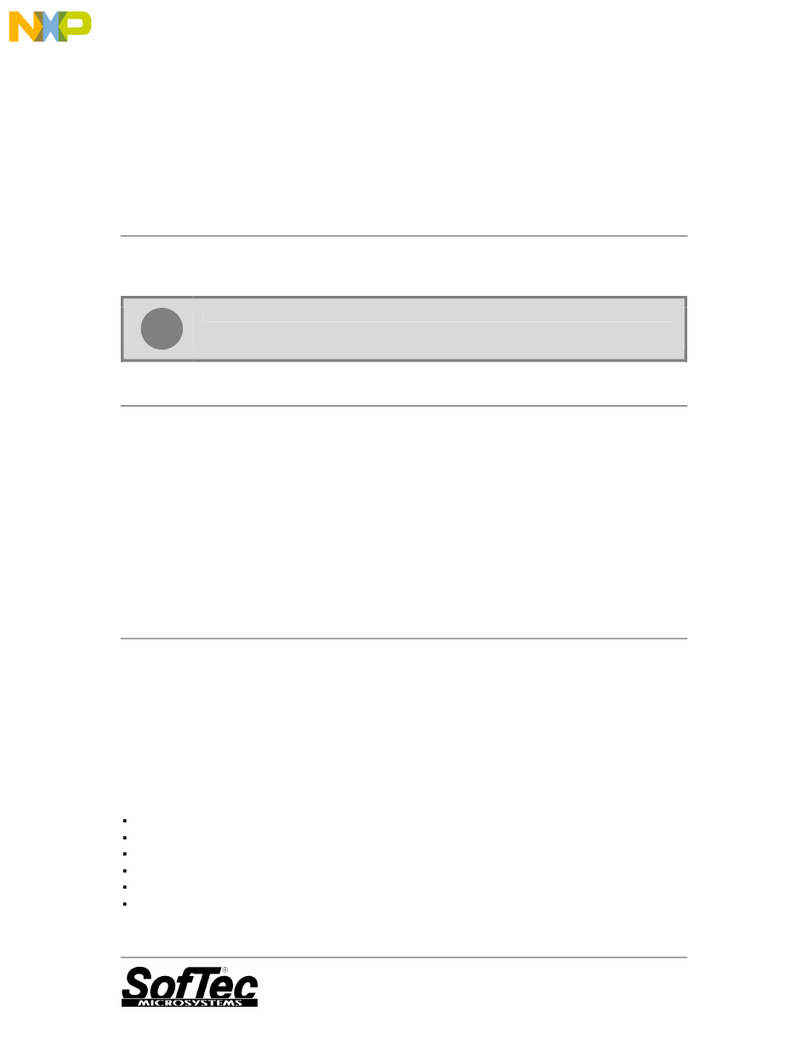
NXP Semiconductors AN11022
CLRC663 evaluation board quick start guide
1 Introduction
This document describes the CLEV6630A and CLEV6630B (CLRC663 evaluation board), which provides an
easy evaluation of the features and functions of the CLRC663 and CLRC663 plus families.
It provides the first steps to operate the board, using the NFC Cockpit (Version 3.6 or higher).
The default antenna is a 65 mm x 65 mm antenna with some metal layer inside the antenna area. This antenna
is not an optimum antenna as such, but intends to demonstrate the performance and register settings of the
CLRC663 under typical design constraints like LCD or some metal (e.g. PCB) inside the antenna area.
In this document the term „MIFARE Classic card“ refers to a MIFARE Classic IC-based contactless card, the
term „MIFARE DESFire card“ refers to a MIFARE DESFire IC-based contactless card.
1.1 CLRC663 registers and EEPROM concept
The CLRC663 uses internal registers to adapt and optimize the functionality and performance for each of the
supported protocols and data rates dependent on the connected antenna, matching network and receiver path.
It offers an EEPROM, which contains the default settings for all the supported protocols (locked). These settings
are loaded into the registers with the LoadProtocol command for each supported protocol and data rate.
The default EEPROM configuration settings are optimized for the generic use, based on the 65mmx65mm
antenna of the board CLEV6630A / CLEV6630B, and cannot be updated by the user as such. Individual
settings must be overwritten by the host µC after the LoadProtocol.
Alternatively, customized settings can be used for the major relevant registers in an extra EEPROM area. Then
the command LoadReg must be used to copy the customized EEPROM content into the registers.
Some of these settings can or even must be adapted towards a new antenna design (e.g. the RX settings).
Some EEPROM configuration data is independent from the used protocols and defines e.g. the startup behavior
of the CLRC663 or the functionality of LowPower Card detection and requires attention as well for optimum
performance of the chip.
1.2 CLEV6630A / CLEV6630B concept
The basic concept of the CLEV6630A / CLEV6630B is to enable the user to perform a quick evaluation of
the CLRC663, and also connect their own antenna to the CLRC663 board. In addition, dedicated boards which
allow to solder custom matching components are available. The NFC Cockpit can be used to optimize the
CLRC663 antenna tuning, to perform the related TX and RX optimization without touching any source code.
All the relevant CLRC663 registers can be modified and fine-tuned using the NFC Cockpit. For the most
relevant registers, the customized settings can typically be stored in the CLRC663 EEPROM.
The NFC Cockpit also allows a dump of the complete user EEPROM content into an XML file. This file then
can be loaded again into the EEPROM. That allows to manage and exchange different user or antenna
configurations. In addition, the register settings found to work well using the NFC Cockpit, can be used during
user code development as well.
As soon as the register settings for the targeted protocols and data rates are defined, the NFC Reader Library
including the HAL can be used to start the development of the user application. Examples illustrate the usage of
the library for typical use cases.
The source code examples of the NFC Reader Library can be used to develop an own application directly
on the LPC1769 (see Figure 3), or can serve as a starting point for porting the NFC Library to any other
microcontroller platform.
AN11022 All information provided in this document is subject to legal disclaimers. © 2023 NXP B.V. All rights reserved.
Application note Rev. 1.6 — 17 May 2023
3 / 46




























